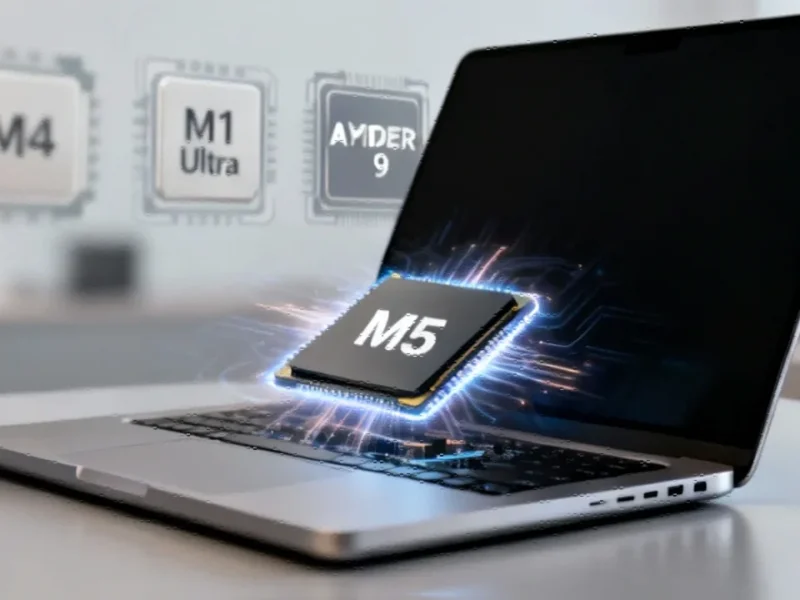Note: Featured image is for illustrative purposes only and does not represent any specific product, service, or entity mentioned in this article.
Unprecedented Single-Core Performance
In a stunning development for the computing industry, leaked benchmark results for Apple’s newly announced M5 chip reveal what appears to be the highest single-core performance ever recorded in the Geekbench 6 database. The benchmark, allegedly from a 14-inch MacBook Pro, shows the M5 achieving a remarkable single-core score of 4,263 points—significantly outpacing even the most powerful current-generation processors from both Apple and competing manufacturers.
This performance breakthrough comes at a time when industry leaders are pushing the boundaries of processing capability across multiple sectors. The M5’s achievement represents not just incremental improvement but a substantial leap forward in single-threaded performance that could redefine expectations for professional computing applications.
Comparative Performance Analysis
When placed alongside current market leaders, the M5’s dominance becomes even more apparent. The chip outperforms Apple’s own M4 Max by approximately 9% and surpasses AMD’s flagship Ryzen 9 processor by an impressive 25% in single-core tasks. Multi-core performance is equally compelling, with the leaked benchmark showing a score of 17,862—roughly 20% faster than the standard M4 chip found in current MacBook Pro models.
What makes these results particularly noteworthy is that they come from the base M5 configuration, suggesting that the forthcoming Pro and Max variants scheduled for 2026 could deliver even more dramatic performance gains. This progression mirrors the performance scaling we’ve observed between M4 and M4 Max processors, where the enhanced versions typically deliver substantial additional computing power for demanding professional workflows.
Architectural Advancements and Real-World Implications
The 14-inch MacBook Pro featuring the M5 chip utilizes a 10-core CPU configuration with four performance cores and six efficiency cores. The record-breaking single-core score reflects the capability of individual performance cores, which directly impacts system responsiveness and performance in applications that cannot effectively utilize multiple cores.
This architectural approach demonstrates how industry developments in processor design continue to evolve, balancing raw performance with energy efficiency. The single-core performance breakthrough has significant implications for:
- Professional applications: Many creative and development tools still rely heavily on single-thread performance
- Gaming experiences: Game engines often depend on strong single-core performance for physics calculations and AI
- System responsiveness: Everyday computing tasks feel noticeably smoother with superior single-core capability
- Future software development: Enables more complex real-time processing and computational tasks
Broader Industry Context
This performance milestone arrives amid significant market trends toward more powerful and efficient computing solutions across industrial and consumer applications. The computing sector continues to witness rapid innovation, with performance breakthroughs occurring alongside important discussions about corporate governance and technological ethics.
Meanwhile, the global technology landscape faces challenges from various directions, including related innovations in emerging markets where political factors can influence technological development and infrastructure stability. These developments highlight the complex interplay between technological advancement and broader socioeconomic factors.
Security and Ethical Considerations
As processing power continues its rapid advancement, the technology community must also address accompanying challenges. The increasing sophistication of computing systems brings with it new vulnerabilities and ethical considerations that merit careful examination.
Recent recent technology discussions have highlighted how advanced computing capabilities can be misappropriated, underscoring the importance of robust security measures alongside performance improvements. This balance between capability and security remains a critical consideration for manufacturers and users alike.
Market Impact and Future Outlook
The M5’s impressive benchmark results arrive during a period of significant industry developments in corporate governance and compensation structures within the technology sector. These parallel developments reflect the multifaceted nature of technological progress, where engineering achievements coexist with evolving business practices and regulatory considerations.
Looking ahead, the computing industry continues to monitor how market trends might influence the adoption and application of these performance breakthroughs across various sectors. The M5’s capabilities suggest new possibilities for professional computing, creative applications, and scientific computing—all areas where single-threaded performance remains crucial.
The 14-inch MacBook Pro with M5 chip is currently available for pre-order with official launch scheduled for October 22. While the professional-grade M5 Pro and Max variants aren’t expected until 2026, the standard M5’s performance already positions it as a formidable contender in the high-performance computing landscape.
This article aggregates information from publicly available sources. All trademarks and copyrights belong to their respective owners.



